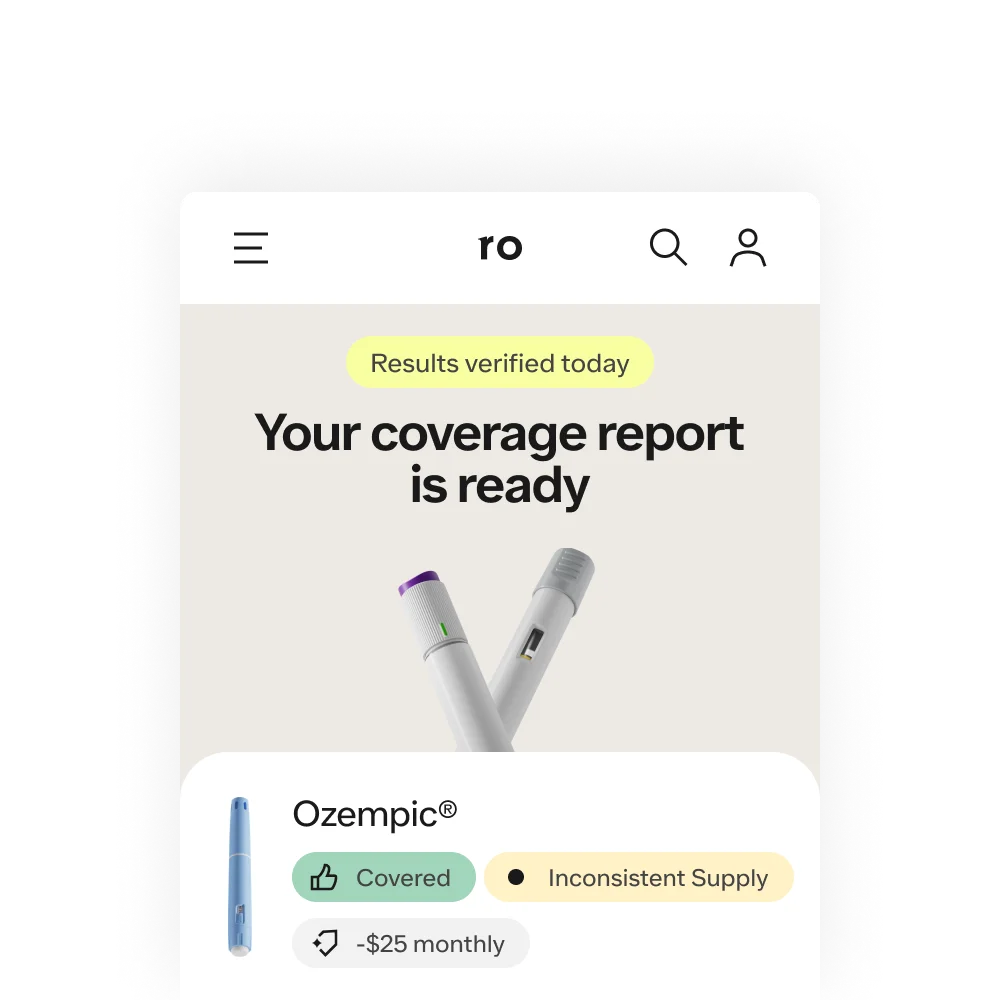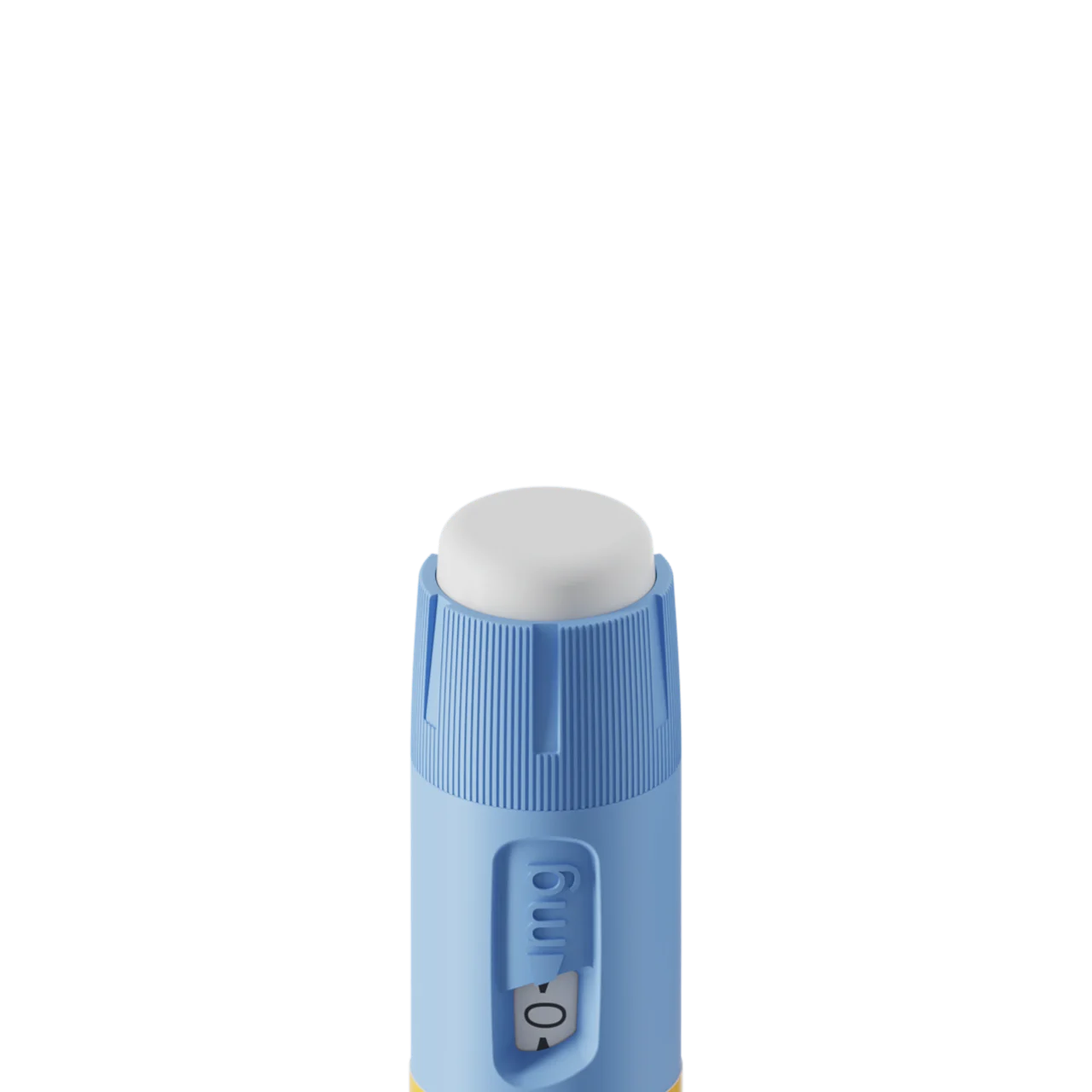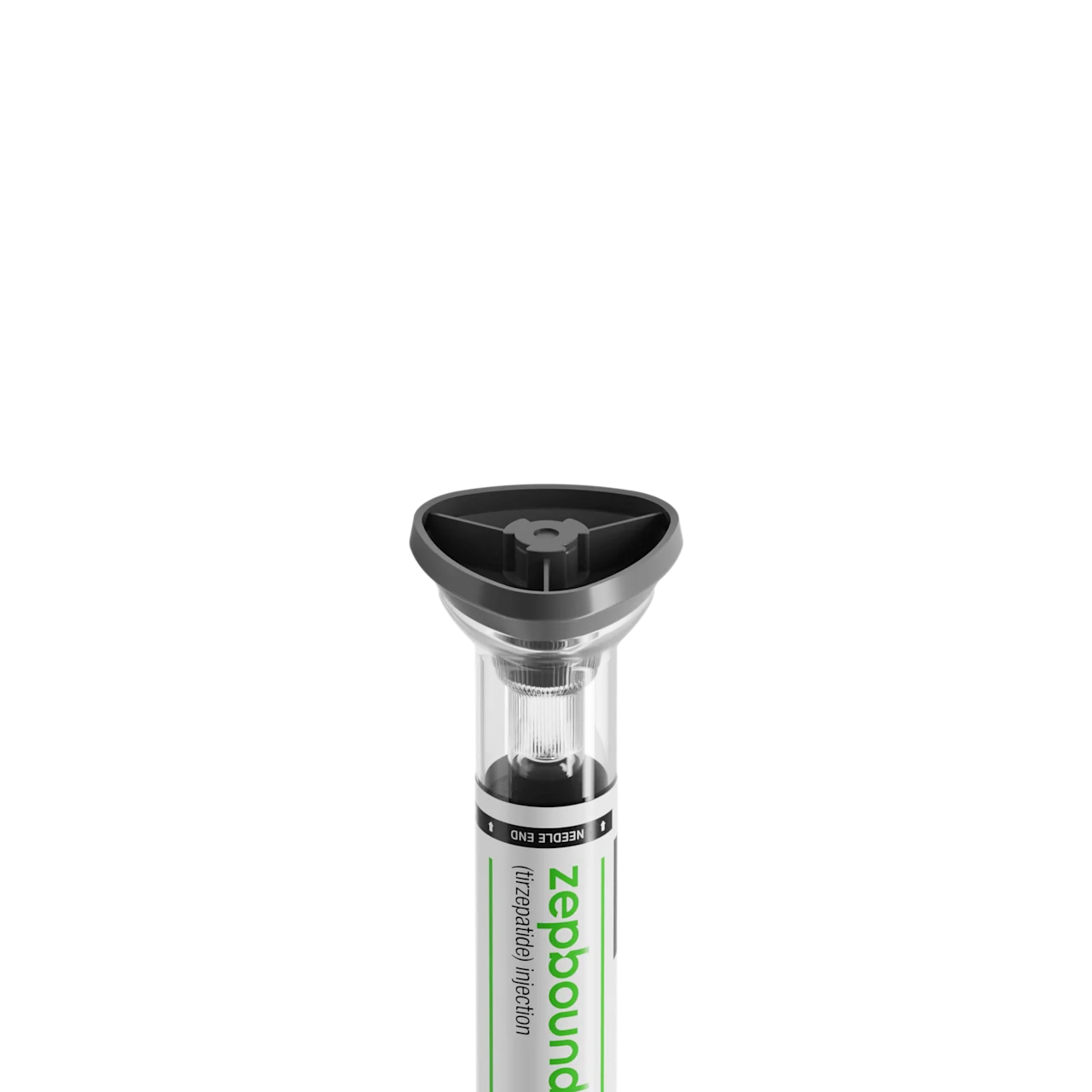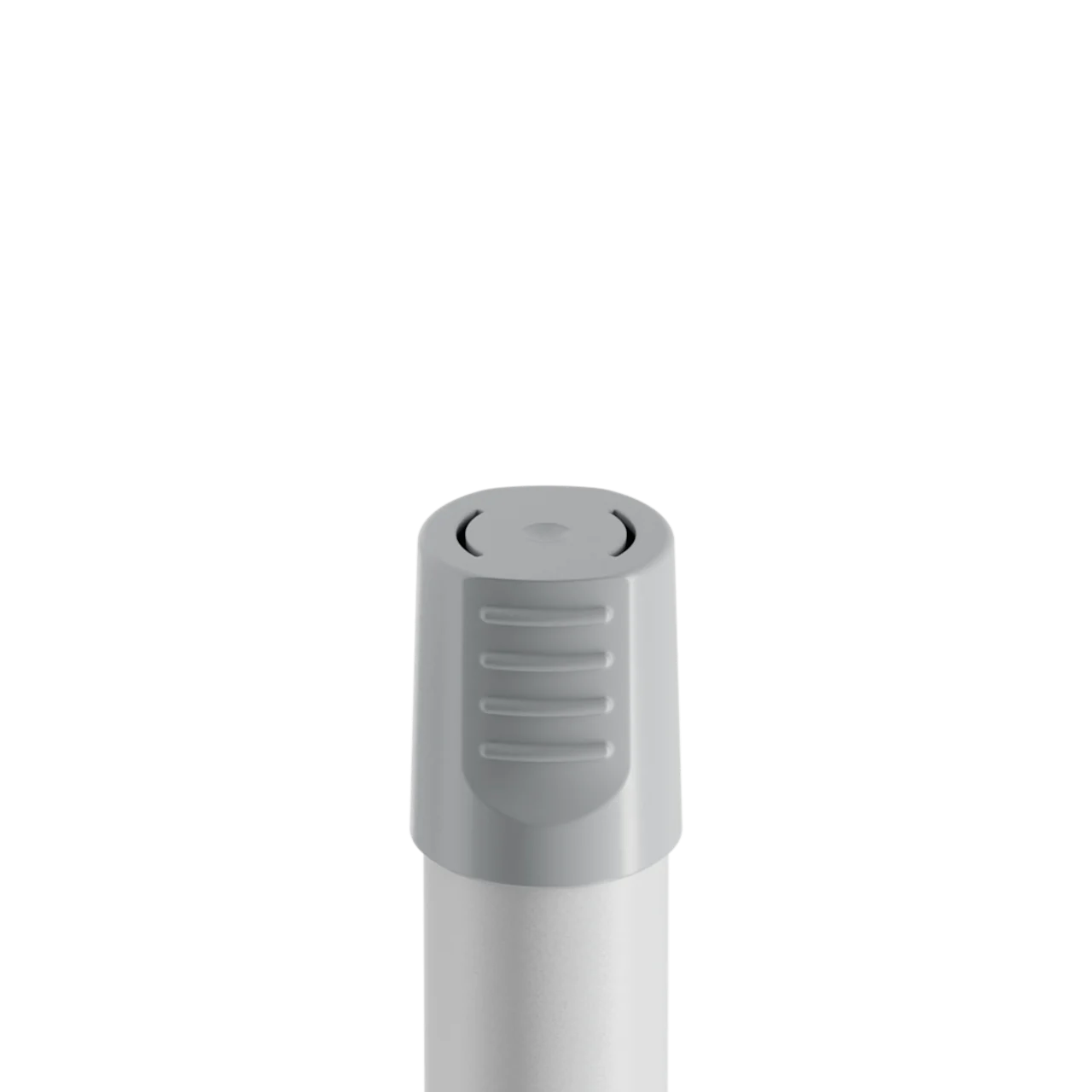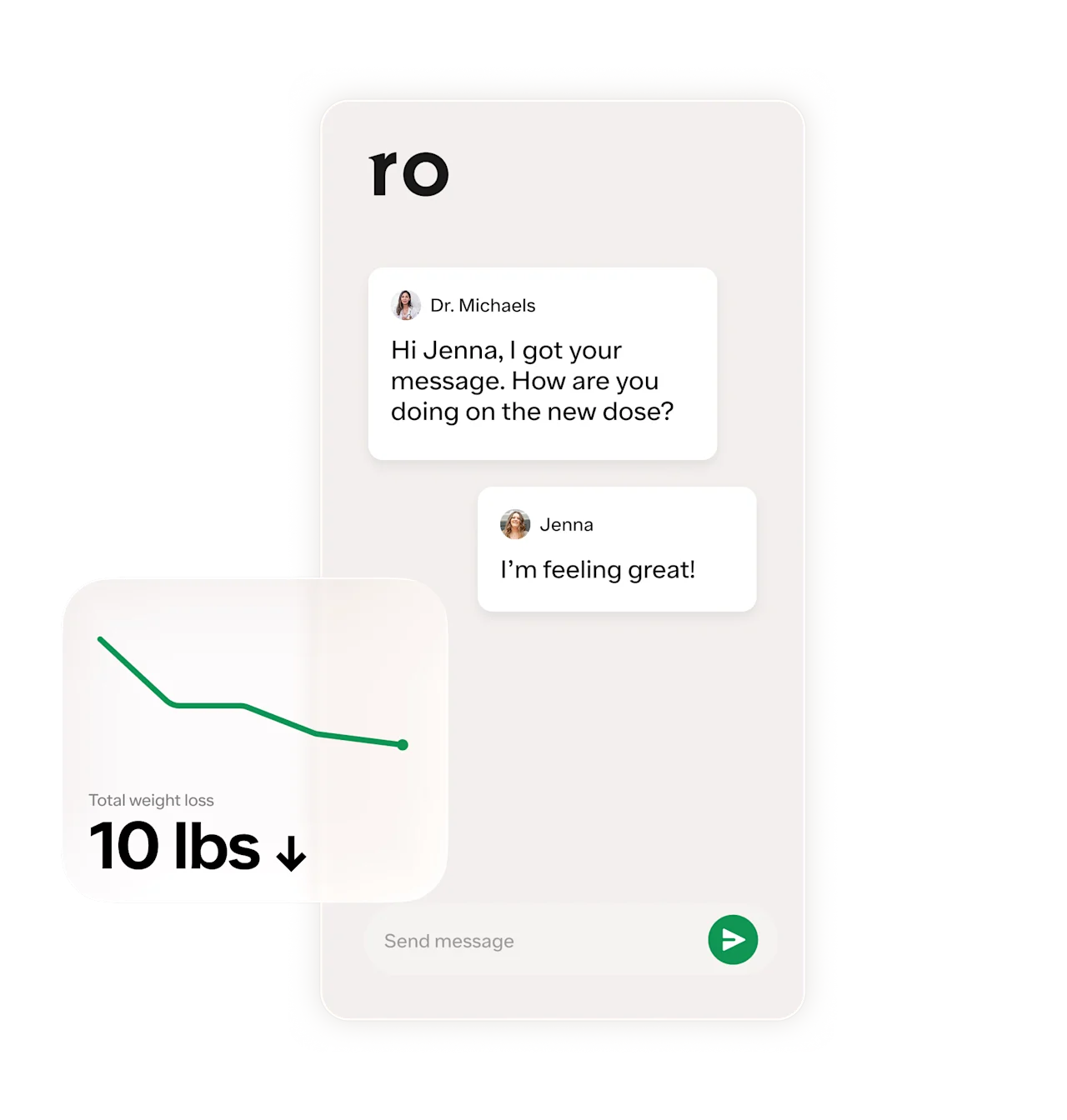Key takeaways
Without insurance, the cost of a semaglutide can range from $200 (for compounded products) to nearly $1,870 (for brand-name versions) per month.
The exact amount you may pay for semaglutide depends on the specific brand-name drug prescribed (e.g. Ozempic, Wegovy, or Rybelsus), health insurance (if any), pharmacy, and location.
The list price of semaglutide varies, with Ozempic at $997.58 per month and Wegovy at $1,349.02 per month, but there are ways to reduce those costs, such as manufacturer savings cards and paying with cash.
Semaglutide can cost as little as $0 per month with insurance, depending on whether you’ve met your deductible and the semaglutide drug being prescribed.
Here's what we'll cover
Key takeaways
Without insurance, the cost of a semaglutide can range from $200 (for compounded products) to nearly $1,870 (for brand-name versions) per month.
The exact amount you may pay for semaglutide depends on the specific brand-name drug prescribed (e.g. Ozempic, Wegovy, or Rybelsus), health insurance (if any), pharmacy, and location.
The list price of semaglutide varies, with Ozempic at $997.58 per month and Wegovy at $1,349.02 per month, but there are ways to reduce those costs, such as manufacturer savings cards and paying with cash.
Semaglutide can cost as little as $0 per month with insurance, depending on whether you’ve met your deductible and the semaglutide drug being prescribed.
Semaglutide is a hot topic thanks to its positive impact on type 2 diabetes, weight loss, and more. But despite its growing popularity, some people may still assume it's too expensive and, thus, out of reach. So, how much does semaglutide cost?
A month’s worth of semaglutide can range from $200 to nearly $1,870 if you’re paying out of pocket. The exact price depends on the specific drug prescribed (e.g. Ozempic, Wegovy, Rybelsus), insurance coverage (if any), and whether you use cash, coupons, or discount programs. If you have insurance, the monthly cost of semaglutide can be anywhere from $0 to hundreds of dollars.
Keep reading to learn more about how much semaglutide costs with and without insurance — plus, tips for lowering the price of your prescription and alternative medications that may be worth discussing with your healthcare provider.
How much does semaglutide cost without insurance?
Without insurance, semaglutide can cost between $200 (for compounded) and nearly $1,870 (for brand-name versions) per month. However, the list price for the brand-name forms of semaglutide ranges from $997.58 to $1,349.02 per month.
Keep in mind that the list price just represents the original price that the drug manufacturer sets for the medication. It doesn’t account for insurance, dosage, discounts, or markups.
Here’s a quick look at the cost of a one-month supply of semaglutide, by drug.
Drug | List price | Average pharmacy retail price |
|---|---|---|
Ozempic | ||
Wegovy | $1,349.02 or $199-$349 (cash price) | |
Rybelsus |
Before digging deeper, here’s a quick refresher: Semaglutide is a glucagon-like peptide-1 (GLP-1) receptor agonist and the active ingredient in several brand-name, prescription medications, including Ozempic, Wegovy, and Rybelsus. While all three have been approved by the US Food and Drug Administration (FDA) and should be used alongside diet and exercise, they have different indications:
Ozempic is a once-weekly injectable medication approved to treat type 2 diabetes; to reduce cardiovascular risk in people with type 2 diabetes and heart disease; and to reduce kidney disease risk in people with type 2 diabetes and chronic kidney disease.
Wegovy is a once-weekly injectable medication approved for weight loss and to reduce cardiovascular risk in people with obesity or overweight and heart disease.
Rybelsus is a daily oral medication approved to treat type 2 diabetes.
These medications also vary in terms of dosage, strengths, and, you guessed it, cost. Regardless of brand name, semaglutide is thought to work the same way: by mimicking GLP-1, a hormone naturally found in your body that plays a key role in controlling blood sugar levels and regulating appetite.
Now, let’s take a closer look at how much semaglutide costs without insurance for each formulation of the drug.
Rx weight loss with Ro
Get access to prescription weight loss medication online
Ozempic
At $997.58 per month as a list price, Ozempic is not cheap. That means that without insurance or discounts, it can cost about $249.40 weekly or up to $11,970.96 annually.
But these estimates are based on the list price. As with any medication, the cost of semaglutide can vary depending on several factors, including health insurance (if any), location, and pharmacy.
Discount codes and savings programs can also impact the price you pay. For example, Novo Nordisk, the manufacturer of Ozempic, Wegovy, and Rybelsus, offers a patient assistance program for uninsured Americans or those on Medicare who meet certain eligibility criteria that are prescribed Ozempic for type 2 diabetes.
Here’s how much an 8 mg/3 mL pen (2 mg dose) of Ozempic costs at different pharmacies, according to SingleCare.
Walgreens | $888.24 |
CVS | $905.27 |
Walmart | $915.25 |
*While prices were valid at the time of publication, they may vary based on date and location. For the most accurate estimates, refresh searches and enter your zip code.
Wegovy
The list price of a 28-day supply of Wegovy is $1,349.02. That’s about $337.26 per week or $16,188.24 per year.
If you don’t have insurance and are paying with cash, you can also get Wegovy for $199-$349 per month through Ro, thanks to its integration with NovoCare, the manufacturer’s online pharmacy. (The $199 per month offer is only available for a limited time, new patients, and for certain doses.)
Unfortunately, Wegovy isn't part of Novo Nordisk’s patient assistance program. So, if you’re uninsured, coupons are likely your best bet for lowering the price of your prescription. But more on that later.
Here's an idea of how much four 0.75 mL pens (each containing a 2.4 mg dose) cost, according to SingleCare.
Walgreens | $1,233.31 |
CVS | $1,300.46 |
Walmart | $1,331.48 |
*While prices were valid at the time of publication, they may vary based on date and location. For the most accurate estimates, refresh searches and enter your zip code.
Rybelsus
Without insurance, a 30-count of 14 tablets of Rybelsus can set you back $997.58. Broken down, that’s about $249.40 per week, $35.63 per day (unlike Wegovy and Ozempic, you take Rybelsus daily), or up to $11,970.96 per year.
Similar to Ozempic, Novo Nordisk offers patient assistance to those who are uninsured or on Medicare. If program criteria are met, you can receive Rybelsus for up to 12 months at no cost.
Here’s the final price for a 30-count of 14 mg tablets, according to SingleCare.
Walgreens | $896.01 |
CVS | $946.54 |
Walmart | $964.66 |
*While prices were valid at the time of publication, they may vary based on date and location. For the most accurate estimates, refresh searches and enter your zip code.
Does insurance cover semaglutide?
Insurance can cover semaglutide, but it often depends on which version of semaglutide you’re taking (Ozempic, Rybelsus, or Wegovy) as well as what you’re taking it for. In general, all three are less likely to be covered by insurance companies when prescribed for weight loss. This applies across private plans, Medicaid (which varies by state), and Medicare (which may cover semaglutide for type 2 diabetes but is currently prohibited from covering weight loss medications altogether).
To find out whether semaglutide is included in your insurance coverage, contact your insurance plan directly or review your plan’s drug formulary, which lists all of the drugs covered by your plan. You can also use tools, such as Ro’s GLP-1 Insurance Coverage Checker, which is free and accessible to all (i.e. not just current patients).
When insurance does cover semaglutide, it’s usually listed as a higher-tier drug, which tends to have higher co-pays. This is the case for both Aetna and Blue Cross Blue Shield, for instance. Prior authorization — and sometimes step therapy — may also be required before semaglutide is covered.
Even if semaglutide is listed, your healthcare provider may need to request prior authorization from the insurance company, seeking approval for the medication based on medical necessity. If this is declined, your provider can then submit an appeal, writing a letter on your behalf requesting an exception.
Compounded semaglutide is not likely to be covered by insurance.
Why doesn’t insurance cover semaglutide for weight loss?
Insurance doesn’t reliably cover semaglutide for weight loss, in part because they don’t reliably cover weight loss medications in general. The law currently prohibits Medicare from covering anti-obesity medications, and many insurance plans may still consider obesity a cosmetic issue rather than a medical one (despite the evidence that obesity is a chronic illness).
How much does semaglutide cost with insurance?
The cost of semaglutide with insurance can range from $0 to several hundred dollars a month. It depends on the details of your plan.
Some plans may fully cover semaglutide, so you can get it for free. Others may require you to pay a copay or deductible.
If you have a commercial insurance plan with coverage for semaglutide — such as a plan through your work — you may also be eligible for the manufacturer’s savings program, which can further bring down the cost of semaglutide.
How to save on or reduce the cost of semaglutide
With or without insurance, there’s no denying that semaglutide can be expensive. But there are ways you can significantly reduce the cost of semaglutide — even if you don’t qualify for Novo Nordisk’s patient assistance program. For example, you can:
Use a pharmacy discount card or coupon
Get a manufacturer savings card
Consider cash-pay options
Consider compounded semaglutide
Coupons and pharmacy discounts
All of the below options offer online databases, which you can use to determine whether your prescribed medication is eligible for discounts, how much you may be able to save, and where these savings are accepted.
Costco Membership Prescription Program: Membership program for Costco members that are uninsured or underinsured through which you can save up to 80% on drug costs, depending on the medication, pharmacy, and your location. Program pricing only applies to in-person or mail-order prescriptions filled at Costco and at participating neighborhood pharmacies.
Optum Perks: Membership program that’s free and available to anyone no matter insurance coverage, if any, through which you can save up to 80% on most prescription drugs, depending on the medication, pharmacy, and your location. Optum Perks offers coupons — which are single-use and specific to individual drugs — as well as a pharmacy discount card — which is a general savings card that can be applied to a range of meds. Both of these can be used at over 64,000 pharmacies in the US.
WellRx: Membership program that’s free and available to anyone through which you can save up to 80% on drug prices, depending on the medication, pharmacy, and your location. Like Optum Perks, WellRx can be used with or without insurance. It also offers coupons for specific medications and a general discount card for various drugs — both of which can be used at 65,000 pharmacies nationwide.
GoodRx: Free service that offers coupons on various medications.
SingleCare: Free service that offers coupons on various medications.
Novo Nordisk’s savings programs
Novo Nordisk also offers savings programs that might help lighten the financial load, though they’re typically reserved for patients with private or commercial insurance. These programs can bring the cost of semaglutide down to $0-$25 if you have coverage and are taking the drug for an FDA-approved indication.
Ozempic: With the Ozempic Savings Card, you can pay as little as $25 for a one-, two- or three-month supply if you have insurance with coverage for Ozempic.
Wegovy: With the Wegovy Savings Card, you can pay as little as $0 for a 28-day supply of Wegovy if you have insurance with coverage for Wegovy. If you’re uninsured or pay cash for your prescriptions, the manufacturer offer caps the monthly cost of the drug at $349 per refill.
Rybelsus: With the Rybelsus Savings Card, you can pay as little as $10 for a one-, two-, or three-month supply if you have insurance with coverage for Rybelsus.
Novo Nordisk also offers a patient assistance program for Americans who are uninsured or on Medicare. To be eligible, you must be taking semaglutide for type 2 diabetes and have a total household income that is at or below 400% of the federal poverty level. If you qualify, you may be able to receive Ozempic or Rybelsus for type 2 diabetes at no cost.
Cash-pay options
For those paying out of pocket, cash-pay options can sometimes offer meaningful savings on semaglutide. Wegovy, for example, is available at discounted prices through Ro thanks to its partnership with NovoCare. Here’s the breakdown:
$199 per month for the first two months (applicable to 0.25 mg and 0.5 mg doses and valid only until March 31, 2026)
$349 per month thereafter
While these cash prices also come with membership costs ($45 for the first month, then $145 per month), the monthly totals are still marginally less than paying for the weight loss medication at its list price of $1,349.02 per month.
Compounded semaglutide
Compounded medications are custom-made by licensed pharmacists to meet a patient’s specific needs when a commercially available drug cannot, such as during a shortage. They aren’t FDA-approved and don’t undergo the same safety, effectiveness, and manufacturing reviews.
Compounded semaglutide, which contains the same active ingredient as Ozempic, Wegovy, and Rybelsus, is one such option. It’s not covered by insurance, but it can be pretty affordable. Depending on the provider, some versions can start as low as $200 per month.
That said, compounded semaglutide is far from the only affordable alternative to brand-name semaglutide. In fact, there are a handful of FDA-approved options that may not break the bank.
Semaglutide alternatives
There are no two ways around it: semaglutide can be expensive. But that doesn’t mean you have to struggle to pay for your meds or give up on getting treatment. If your insurance won’t cover semaglutide or you’re paying out-of-pocket for your prescription, consider asking your healthcare provider about these alternatives to semaglutide:
Mounjaro or Zepbound
Metformin
Victoza or Saxenda
Phentermine/topiramate
Naltrexone/bupropion
Orlistat
Mounjaro or Zepbound
Mounjaro and Zepbound are once-weekly injections containing tirzepatide as the active ingredient.
Mounjaro is FDA-approved for controlling blood sugar in adults with type 2 diabetes, similar to Ozempic and Rybelsus.
Cost: $1,079.77/month
Zepbound is FDA-approved for chronic weight management in adults with obesity or adults with overweight and a weight-related health condition (e.g. high blood pressure, type 2 diabetes, or heart disease). It’s also FDA-approved for obstructive sleep apnea.
Cost (pens): $1,086.37/month
Cost (vials): $299-$449/month, depending on dose, when you pay with cash through Ro and Eli Lilly
Metformin
Metformin (Glumetza, Fortamet) is an oral medication that treats type 2 diabetes by controlling blood sugar levels. It’s often prescribed off-label for PCOS and weight loss.
Cost: A month’s supply of 500 mg extended-release tablets of generic metformin can cost as little as $4, according to SingleCare
Victoza or Saxenda
Victoza and Saxenda are daily injections. Similar to Ozempic and Wegovy, Victoza and Saxenda share the same active ingredient — liraglutide — but are FDA-approved for different indications.
Victoza is approved to treat type 2 diabetes when used with diet and exercise and reduce cardiovascular risk in adults with type 2 diabetes and heart disease.
Cost: $543.51–$815.27/month, depending on the dosage.
Saxenda is approved for weight loss when used with diet and exercise.
Cost: $1,349.02/month
Weight loss pills
For those taking semaglutide for weight loss, oral appetite suppressants can be an affordable alternative. The FDA has approved the following prescription weight loss pills for chronic weight management:
Phentermine/topiramate (Qsymia), taken once daily.
Naltrexone/bupropion (Contrave), taken twice daily
Orlistat (Xenical), taken three times daily.
The prices of these medications vary depending on whether you’re prescribed the brand-name or generic version, your location, preferred pharmacy, and insurance coverage.
Bottom line
Semaglutide can be a powerful tool for managing type 2 diabetes, chronic weight challenges, and other conditions, but it often comes with a steep price tag. So, how much is semaglutide? Unfortunately, there’s no one set answer. But here’s the gist:
The cost of semaglutide varies based on the formulation prescribed (brand name or compounded), insurance coverage, pharmacy, and location. Since there’s no generic version, you can generally expect brand-name pricing, which typically means a higher cost.
Without insurance, a month’s supply of semaglutide is typically under $1,870. More specifically, the list price for Ozempic is $997.58, $1,349.02 for Wegovy, and $997.58 for Rybelsus.
While it tends to be more affordable than the brand-name, FDA-approved drugs, compounded semaglutide is not FDA-approved and is not usually covered by health insurance. Semaglutide alternatives that are approved by the FDA include Mounjaro, Zepbound, metformin, Victoza, Saxenda, and more.
With insurance, the cost of semaglutide could drop to as little as $0, especially if you qualify for a manufacturer savings card. Pharmacy discounts and coupon cards, such as those available online, can also reduce the price of your prescription.
Frequently asked questions (FAQs)
How much does semaglutide cost per month?
With insurance, the cost of semaglutide ranges from $0 to several hundred dollars a month. It depends on the details of your plan. Without insurance, the cost of semaglutide can range from $200 for compounded versions to nearly $1,870 for brand-name versions per month.
How much is a 30-day supply of semaglutide?
Semaglutide’s cost depends on the specific drug (i.e. brand), your location, pharmacy, insurance coverage, among other factors. Keep in mind that discounts are available, and some Medicare and private health insurance plans help cover costs. That said, here are the list prices for about a month’s worth of each brand-name semaglutide drug, according to their manufacturer, Novo Nordisk.
Ozempic (2 mg/week): $997.58
Wegovy (2.4 mg/week): $1,349.02 or $349 through Ro and NovoCare (cash price)
Rybelsus (14 mg/day): $997.58
*List price for one month supply, according to Novo Nordisk. Your actual cost may vary depending on your location, pharmacy, insurance coverage, and eligibility for savings programs.
| Ozempic | Wegovy | Rybelsus |
|---|---|---|---|
Dose | 2 mg/week | 2.4 mg/week | 14 mg/day |
Cost without insurance | $997.58 | $1,349.02 or $349 (cash price) | $997.58 |
*List price for one month supply, according to Novo Nordisk. Your actual cost may vary depending on your location, pharmacy, insurance coverage, and eligibility for savings programs.
How can you get semaglutide for $25?
Depending on your insurance, you may be able to get semaglutide for $25 a month — or less. Novo Nordisk estimates most patients pay between $0-$25 out-of-pocket if insurance covers the prescription. For a better idea of what you’ll pay, refer to your insurance plan’s prescription coverage.
DISCLAIMER
If you have any medical questions or concerns, please talk to your healthcare provider. The articles on Health Guide are underpinned by peer-reviewed research and information drawn from medical societies and governmental agencies. However, they are not a substitute for professional medical advice, diagnosis, or treatment.
Ozempic Important Safety Information: Read more about serious warnings and safety info.
Wegovy Important Safety Information: Read more about serious warnings and safety info.
GLP-1 Important Safety Information: Read more about serious warnings and safety info.
Mounjaro Important Safety Information: Read more about serious warnings and safety info.
Zepbound Important Safety Information: Read more about serious warnings and safety info.
Saxenda Important Safety Information: Read more about serious warnings and safety info.
References
Costco. (n.d.). Member Prescription Program. Retrieved from https://www.costco.com/cmpp
Eli Lilly-a. (2025). How much should I expect to pay for Mounjaro?. Retrieved from https://pricinginfo.lilly.com/mounjaro
Eli Lilly-b. (2025). How much should I expect to pay for Zepbound?. Retrieved from https://pricinginfo.lilly.com/zepbound
GoodRx. (n.d.). Welcome to GoodRx for HCPs. Retrieved from https://www.goodrx.com/hcp
Green, L., & Taddei-Allen, P. (2023). Shifting paradigms: Reframing coverage of antiobesity medications for plan sponsors. Journal of Managed Care & Specialty Pharmacy, 29(5), 564–568. doi:10.18553/jmcp.2023.29.5.564. Retrieved from https://pmc.ncbi.nlm.nih.gov/articles/PMC10387974/
Hernandez, I., San-Juan-Rodriguez, A., Good, C. B., & Gellad, W. F. (2020). Changes in List Prices, Net Prices, and Discounts for Branded Drugs in the US, 2007-2018. JAMA, 323(9), 854–862. doi:10.1001/jama.2020.1012. Retrieved from https://pubmed.ncbi.nlm.nih.gov/32125403/
H.R. 4818, 118th Cong. (2023). Unemployment Insurance Improvement and Modernization Act. Retrieved from https://www.congress.gov/bill/118th-congress/house-bill/4818
Luo, J., Feldman, R., Rothenberger, S. D., et al. (2020). Coverage, Formulary Restrictions, and Out-of-Pocket Costs for Sodium-Glucose Cotransporter 2 Inhibitors and Glucagon-Like Peptide 1 Receptor Agonists in the Medicare Part D Program. JAMA Network Open, 3(10), e2020969. doi:10.1001/jamanetworkopen.2020.20969. Retrieved from https://pmc.ncbi.nlm.nih.gov/articles/PMC7563069/
Novocare-a. (2024). Find out the cost for Ozempic. Retrieved from https://www.novocare.com/diabetes/products/ozempic/explaining-list-price.html
Novocare-b. (2024). Find out the cost for Rybelsus. Retrieved from https://www.novocare.com/diabetes/products/rybelsus/explaining-list-price.html
Novocare-c. (2024). Patient Assistance Program. Retrieved from https://www.novocare.com/diabetes/help-with-costs/pap.html
Novocare-d. (2025). What NovoCare Pharmacy offers. Retrieved from https://www.novocare.com/obesity/products/wegovy/get-product.html?nofollow
Novocare-e. (2025). What is the list price for Wegovy and will it impact me? Retrieved from https://www.novocare.com/obesity/products/wegovy/let-us-help/explaining-list-price.html
NovoCare-f. (2023). What is the list price for Saxenda and will it impact me? Retrieved from https://www.novocare.com/obesity/products/saxenda/explaining-list-price.html
Novo Nordisk-a. (n.d.). Save on Ozempic. Retrieved from https://www.ozempic.com/savings-and-resources/save-on-ozempic.html
Novo Nordisk-b. (n.d.). Save on Wegovy. Retrieved from https://www.wegovy.com/coverage-and-savings/save-on-wegovy.html
Novo Nordisk-c. (n.d.). Savings and support for Rybelsus. Retrieved from https://www.rybelsus.com/savings-and-support.html
Novo Nordisk-d. (n.d.). Victoza Pricing. Retrieved from https://www.novopricing.com/victoza.html
Optum Perks. (n.d.). Get your free prescription discount card! Retrieved from https://perks.optum.com/discount-card
SingleCare-b. (n.d.). Metformin Hcl Er Coupons & Prices. Retrieved from https://www.singlecare.com/prescription/metformin-hcl-er?q=Metformin%20Hcl%20Er
SingleCare-d. (n.d.). Ozempic Coupons & Prices. Retrieved from https://www.singlecare.com/prescription/ozempic?q=Ozempic
SingleCare-f. (n.d.). Rybelsus Coupons & Prices. Retrieved from https://www.singlecare.com/prescription/rybelsus?q=Rybelsu
SingleCare-g. (n.d.). SingleCare. Retrieved from https://www.singlecare.com/
SingleCare-h. (n.d.). Wegovy Coupons & Prices. Retrieved from https://www.singlecare.com/prescription/wegovy?q=Wegovy
Tchang, B. G., Aras, M., Kumar, R. B., et al. (2024). Pharmacologic Treatment of Overweight and Obesity in Adults. Endotext [Internet]. Retrieved from https://www.ncbi.nlm.nih.gov/books/NBK279038/
U.S. Food and Drug Administration (FDA-a). (2025). Highlights of Prescribing Information: Contrave (naltrexone- hydrochloride and bupropion hydrochloride) extended-release tablets, for oral use. Retrieved from https://www.accessdata.fda.gov/drugsatfda_docs/label/2025/200063s024s026lbl.pdf
U.S. Food and Drug Administration (FDA). (2018). Highlights of Prescribing Information: Fortamet (metformin hydrochloride) extended-release tablets, for oral use. Retrieved from https://www.accessdata.fda.gov/drugsatfda_docs/label/2018/021574s017lbl.pdf
U.S. Food & Drug Administration (FDA-b). (2025). Highlights of Prescribing Information: Mounjaro (tirzepatide) Injection, for subcutaneous use. Retrieved from https://www.accessdata.fda.gov/drugsatfda_docs/label/2025/217806s031lbl.pdf
U.S. Food & Drug Administration (FDA-c). (2025). Highlights of Prescribing Information: Ozempic (semaglutide) injection, for subcutaneous use. Retrieved from https://www.accessdata.fda.gov/drugsatfda_docs/label/2025/209637s035,209637s037lbl.pdf
U.S. Food and Drug Administration (FDA). (2024). Highlights of Prescribing Information: Qsymia (phentermine and topiramate extended-release capsules), for oral use, CIV. Retrieved from https://www.accessdata.fda.gov/drugsatfda_docs/label/2024/022580s026lbl.pdf
U.S. Food and Drug Administration (FDA-d). (2025). Highlights of Prescribing Information: Rybelsus (semaglutide) tablets, for oral use. Retrieved from https://www.accessdata.fda.gov/drugsatfda_docs/label/2025/213051s024,s028s029lbl.pdf
U.S. Food and Drug Administration (FDA-e). (2025). Highlights of Prescribing Information: Saxenda (liraglutide) injection, for subcutaneous use. Retrieved from https://www.accessdata.fda.gov/drugsatfda_docs/label/2025/206321s022lbl.pdf
U.S. Food and Drug Administration (FDA-f). (2025). Highlights of Prescribing Information: Victoza (liraglutide) injection, for subcutaneous use. Retrieved from https://www.accessdata.fda.gov/drugsatfda_docs/label/2025/022341s046lbl.pdf
U.S. Food & Drug Administration (FDA-g). (2025). Highlights of Prescribing Information: Wegovy (semaglutide) injection, for subcutaneous use. Retrieved from https://www.accessdata.fda.gov/drugsatfda_docs/label/2024/215256s015lbl.pdf
U.S. Food and Drug Administration (FDA). (2022). Highlights of Prescribing Information: Xenical (orlistat) capsules, for oral use. Retrieved from https://www.accessdata.fda.gov/drugsatfda_docs/label/2022/020766s038lbl.pdf
U.S. Food & Drug Administration (FDA-h). (2025). Highlights of Prescribing Information: Zepbound (tirzepatide) Injection, for subcutaneous use. Retrieved from https://www.accessdata.fda.gov/drugsatfda_docs/label/2025/217806s031lbl.pdf
WellRx. (n.d.) Get Your Rx Discount Card. Retrieved from https://www.wellrx.com/rx-discount-card/enroll/
Young, G. M., Bansal, K., Riello, R. J., 3rd, et al. (2024). Medicare Coverage and Patient Out-of-Pocket Costs for Cardiovascular-Kidney-Metabolic Medications. JAMA Network Open, 7(5), e2412437. doi: 10.1001/jamanetworkopen.2024.12437. Retrieved from https://www.ncbi.nlm.nih.gov/pmc/articles/PMC11109768/


